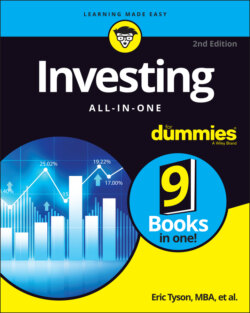Читать книгу Investing All-in-One For Dummies - Eric Tyson - Страница 39
Stock returns
ОглавлениеInvestors expect a fair return on their stock investments. If one investment doesn’t offer a seemingly high enough potential rate of return, investors can choose to move their money into other investments that they believe will perform better. Instead of buying a diversified basket of stocks and holding, some investors frequently buy and sell, hoping to cash in on the latest hot investment. This tactic seldom works in the long run.
Unfortunately, some of these investors use a rearview mirror when they purchase their stocks, chasing after investments that have recently performed strongly on the assumption (and the hope) that those investments will continue to earn good returns. But chasing after the strongest performing investments can be dangerous if you catch the stock at its peak, ready to begin a downward spiral. Chasing high-flying investments can lead you to buy high, with the prospect of having to sell low if the stock runs out of steam. Even though stocks as a whole have proved to be a good long-term investment, picking individual stocks is a risky endeavor. See Book 3 for advice on making sound stock investment decisions.
A tremendous amount of data exists regarding stock market returns. In fact, in the U.S. markets, data going back more than two centuries document the fact that stocks have been a terrific long-term investment. The long-term returns from stocks that investors have enjoyed, and continue to enjoy, have been remarkably constant from one generation to the next.
Going all the way back to 1802, the U.S. stock market has produced an annual return of 8.3 percent, while inflation has grown at 1.4 percent per year. Thus, after subtracting for inflation, stocks have appreciated about 6.9 percent faster annually than the rate of inflation. The U.S. stock market returns have consistently and substantially beaten the rate of inflation over the years (see Figure 2-5).
Stocks don’t exist only in the United States, of course (see Figure 2-6). More than a few U.S. investors seem to forget this fact, as they did during the sizzling performance of the U.S. stock market during the late 1990s and 2010s. As discussed in the earlier section “Diversify for a smoother ride,” one advantage of buying and holding overseas stocks is that they don’t always move in tandem with U.S. stocks. As a result, overseas stocks help diversify your portfolio.
© John Wiley & Sons, Inc.
FIGURE 2-5: History shows that stocks have been a consistent long-term winner.
© John Wiley & Sons, Inc.
FIGURE 2-6: Plenty of investing opportunities exist outside the United States.
In addition to enabling U.S. investors to diversify, investing overseas has proved to be profitable. The investment banking firm Morgan Stanley tracks the performance of stocks in both economically established countries and so-called emerging economies. As the name suggests, countries with emerging economies (for example, Brazil, China, India, Malaysia, Mexico, Russia, and Taiwan) are “behind” economically but show high growth and progress rates.
Stocks are the best long-term performers, but they have more volatility than bonds and Treasury bills. A balanced portfolio gets you most of the long-term returns of stocks without much of the volatility.
